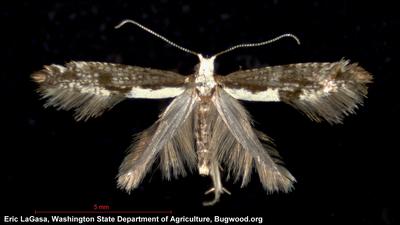Apple Fruit Moth
Argyresthia conjugella
Insect
In a Nutshell
- Wrinkled fruit skin.
- Discolored, sunken patches.
- Small exit holes.
Can also be found in
Symptoms
Apple fruits are riddled with tunnels. Their skin becomes wrinkled and marked with small discolored, sunken lesions. In later stages the skin appears pierced by numerous small holes and brown speckles.
Recommendations

Organic Control
Bacillus thuringiensis galleriae is recommended to control the pest population. The apple fruit moth has several parasitoids that attack the larvae.

Chemical Control
Always consider an integrated approach with preventive measures together with biological treatments if available. Practice edge spraying to protect the inner laying trees before moths start migration. Under severe infestation the whole orchard should be sprayed. Insecticides containing Azinphos-methyl, diflubenzuron are recommended to control the pest population. To protect next season infestation, soil treatment with recommended dusts or cabofuran 3g to be applied (1-1.5kg/ha). Also, spray twice Chlorpyriphos (20EC) at 15 days interval.
What caused it?
The damage is caused by the larvae of Argyresthia conjugella. Their natural host is sorbus aucuparia (rowan) but when the tree's berry production is low it will migrate to apple trees. The small brown and white adult moths appear in summer, when females oviposit on apple fruitlets. The larvae bore directly into the developing fruit and feeds on it. When the larvae is fully grown it will drop to the ground, pupate and overwinter in the soil. Heavy rains, cold temperatures influence the pest population negatively. Late apple varieties are affected the most. Yield can be severely reduced as the fruits become unmarketable.
Preventive Measures
- Monitor your orchard regularly.
- Install pheromone traps (2-phenyl ethanol and anethol) @ 45/acre separated by 75 feet.
- Change the lures at a 2-3 week interval.
- Thin the tree crowns to provide good air circulation.



